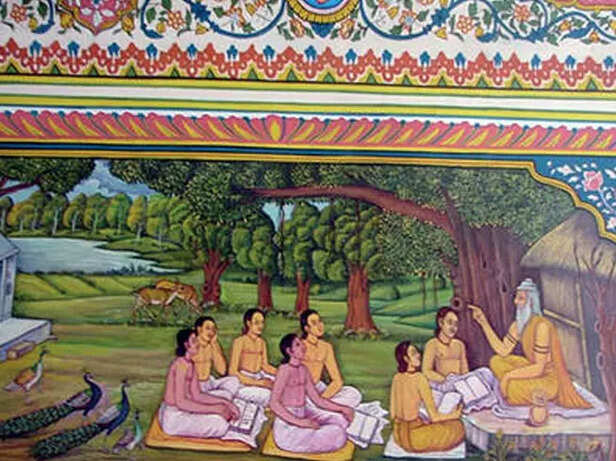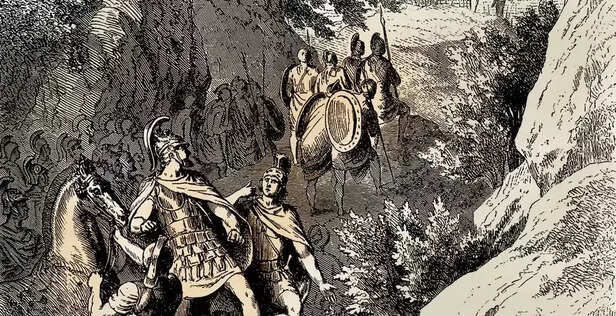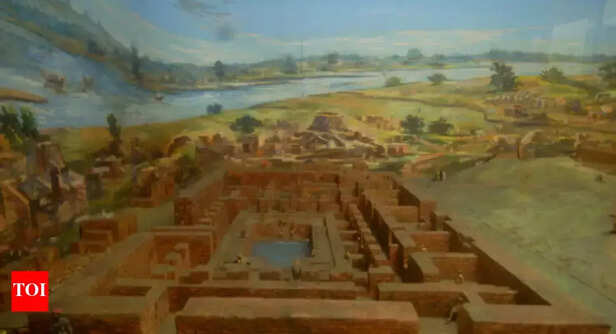From Sindhu to Indus: The River That Shaped Empires and Still Divides Nations!
Nidhi | Jan 21, 2025, 15:08 IST
( Image credit : Timeslife )
"From Sindhu to Indus: The River That Shaped Empires and Still Divides Nations" traces the remarkable journey of the Sindhu River, once the lifeline of the ancient Indus Valley Civilization, and its transformation into the modern Indus. This river has not only fostered thriving cultures but also played a crucial role in shaping the political and economic landscape of South Asia. The article delves into its historical, cultural, and geopolitical significance, examining how the river has influenced civilizations, fueled conflicts, and continues to be at the heart of modern disputes between India and Pakistan.
"Sindhu mere mann ki baat samajhti hai. Is paani mein humara itihas basta hai." These words capture a deep truth about the Sindhu River, known today as the Indus. More than just a body of water, the Sindhu has been the lifeblood of civilizations, a witness to power struggles, and a symbol of spiritual connection. The river has flowed through time, shaping the history and geopolitics of South Asia. From ancient civilization to modern-day conflicts, the Sindhu's journey is as rich as it is complex.Let us embark on a historical journey to explore the river's significance, from the cradle of civilization to the geopolitical and cultural battles that continue to this day.
 The Sindhu River, which runs through modern-day Pakistan, was at the heart of the Indus Valley Civilization (c. 3300–1300 BCE), one of the world’s earliest urban cultures. Cities like Mohenjo-Daro and Harappa, located along the Sindhu's banks, were some of the first urban centers in human history. This civilization was one of the first to develop complex urban planning and advanced drainage systems, showcasing the river's significance to the people who lived along it.
The Sindhu River, which runs through modern-day Pakistan, was at the heart of the Indus Valley Civilization (c. 3300–1300 BCE), one of the world’s earliest urban cultures. Cities like Mohenjo-Daro and Harappa, located along the Sindhu's banks, were some of the first urban centers in human history. This civilization was one of the first to develop complex urban planning and advanced drainage systems, showcasing the river's significance to the people who lived along it.

As the Indus Valley Civilization faded, the Sindhu continued to play a vital role in the Vedic period (c. 1500–600 BCE). The river's significance transcended the material world and became intertwined with spirituality. In the Rigveda, the Sindhu is personified as a goddess—an embodiment of strength and life-giving power.

In the 6th century BCE, the Persian Empire under Darius I expanded its territory to include the lands of the Sindhu. They recognized its importance as a natural boundary and a source of irrigation. The river also became known to Greek historians, thanks to Alexander the Great’s invasion in 326 BCE.
 The Mauryan Empire (c. 321–185 BCE), founded by Chandragupta Maurya, saw the Sindhu as a central artery for the administration and expansion of their vast empire. Under Ashoka, the Mauryas spread the teachings of Buddhism far beyond the river's banks.
The Mauryan Empire (c. 321–185 BCE), founded by Chandragupta Maurya, saw the Sindhu as a central artery for the administration and expansion of their vast empire. Under Ashoka, the Mauryas spread the teachings of Buddhism far beyond the river's banks.
The Arab conquest of Sindh in 712 CE, led by Muhammad bin Qasim, marked a new chapter in the region’s history. The Sindhu, once a boundary of empires, became a point of convergence for Islamic and Indian cultures.
Impact:

The British colonial period saw the transformation of the Sindhu into a key economic resource. The British engineered extensive irrigation projects, turning the river basin into a vital agricultural region that served imperial needs.
Significant Developments:

In the modern era, the Sindhu remains both a lifeline and a source of political tension. The river’s waters continue to sustain millions, but its strategic importance has made it a point of conflict in India-Pakistan relations.
Modern Context:
The Sindhu's journey through history is more than just the story of a river. It is a reflection of humanity's resilience and its ability to adapt, survive, and thrive in the face of challenges. From the dawn of civilization to modern-day geopolitical struggles, the river has played a central role in shaping the culture, economy, and politics of South Asia.
As the Sindhu continues to flow, it reminds us of the deep connections that bind humanity to the land and to one another. The river may have become the Indus, but its legacy endures, carrying with it the hopes, struggles, and triumphs of countless generations. A true river of destiny, it continues to define the region, shaping its past and influencing its future.
1. Sindhu: The Cradle of Civilization

Archeological Site
( Image credit : Timeslife )
Key Contributions:
- Agricultural Backbone: The river’s seasonal flooding enriched the soil, making it one of the earliest agricultural powerhouses. The fertile lands provided sustenance for large populations, supporting an advanced urban society.
- Urban Marvels: Cities such as Mohenjo-Daro and Harappa featured well-planned street grids, sophisticated drainage systems, and public baths, signifying a deep understanding of urban management.
- Cultural Influence: Artifacts such as seals, pottery, and tools uncovered at these sites highlight a society deeply integrated with nature and commerce. Their extensive trade networks reached as far as Mesopotamia, showcasing the river's central role in economic and cultural exchange.
2. The Vedic Era: Sindhu as a Sacred Entity

Vedic Period
( Image credit : Timeslife )
As the Indus Valley Civilization faded, the Sindhu continued to play a vital role in the Vedic period (c. 1500–600 BCE). The river's significance transcended the material world and became intertwined with spirituality. In the Rigveda, the Sindhu is personified as a goddess—an embodiment of strength and life-giving power.
Key Developments:
- Spiritual Symbolism: The Vedic hymns often describe the Sindhu as a nurturing force, symbolizing life’s cyclical nature. The river's vastness was seen as a divine manifestation, representing a force beyond human comprehension.
- The Birth of a Name: The Persian invaders referred to the Sindhu as "Hindhu," from which the term "Hindu" is derived. Over time, this term extended to describe the region and the people, ultimately leading to the name "India."
3. Persian and Greek Influences: Sindhu Becomes Indus

Alexander’s Encounter
( Image credit : Timeslife )
In the 6th century BCE, the Persian Empire under Darius I expanded its territory to include the lands of the Sindhu. They recognized its importance as a natural boundary and a source of irrigation. The river also became known to Greek historians, thanks to Alexander the Great’s invasion in 326 BCE.
Key Events:
- Persian Administration: The Achaemenid Empire utilized the Sindhu for its strategic value. It became an important irrigation source, helping the Persians strengthen their control over the region.
- Alexander’s Encounter (326 BCE): When Alexander crossed the Sindhu, it was more than just a military endeavor. The Greeks, led by historians like Megasthenes, chronicled the river and its people, calling it the "Indus," a name that would become synonymous with the Indian subcontinent.
4. The Mauryan Empire: A Unifier of Territories

Mauryan
( Image credit : Timeslife )
Key Roles:
- Economic Hub: The Sindhu facilitated the movement of goods and people, contributing to the growth of the Mauryan economy. It played a central role in the empire’s economic network, enhancing trade routes that connected the subcontinent with the Mediterranean and Central Asia.
- Ashoka’s Mission: Ashoka, the Mauryan emperor, utilized the Sindhu to spread Buddhist teachings. Monks traveled along the river, bringing the message of peace and enlightenment to distant lands.
5. The Arab Conquest: Sindh as the Gateway
Impact:
- Cultural Synthesis: The Arab presence in Sindh led to a blending of Hindu and Islamic traditions, influencing local art, architecture, and language. The river became a symbol of cultural fusion, with a lasting impact on the subcontinent.
- Trade Flourishes: The Sindhu also remained a crucial trade route, connecting the subcontinent to the Middle East. This facilitated the exchange of goods, ideas, and culture, contributing to the region’s prosperity.
6. Colonial Exploitation: Indus as an Imperial Asset

East India Company
( Image credit : Timeslife )
The British colonial period saw the transformation of the Sindhu into a key economic resource. The British engineered extensive irrigation projects, turning the river basin into a vital agricultural region that served imperial needs.
Significant Developments:
- Canal Colonies: The British developed the Indus basin into an agricultural powerhouse by constructing canals. This not only transformed the landscape but also displaced local communities, leading to significant social and cultural changes.
- Partition Woes: The partition of India in 1947 saw the Indus become a symbol of division. The river’s waters became a contentious issue between India and Pakistan, leading to the signing of the 1960 Indus Waters Treaty, which sought to resolve disputes over water distribution.
7. Sindhu in Modern Times: A Source of Tension and Reverence

Indus
( Image credit : Timeslife )
In the modern era, the Sindhu remains both a lifeline and a source of political tension. The river’s waters continue to sustain millions, but its strategic importance has made it a point of conflict in India-Pakistan relations.
Modern Context:
- Geopolitical Significance: The Indus and its tributaries are at the heart of India-Pakistan relations. The 1960 Indus Water Treaty, while designed to resolve disputes, has not entirely quelled tensions. The river’s water usage remains a highly sensitive issue.
- Cultural Reawakening: Efforts to preserve and honor the Sindhu’s legacy have become central to the cultural identity of South Asia. Festivals like Sindhu Darshan celebrate the river’s spiritual significance and its role in the region’s history.
Conclusion: A River Beyond Borders and Time
As the Sindhu continues to flow, it reminds us of the deep connections that bind humanity to the land and to one another. The river may have become the Indus, but its legacy endures, carrying with it the hopes, struggles, and triumphs of countless generations. A true river of destiny, it continues to define the region, shaping its past and influencing its future.
